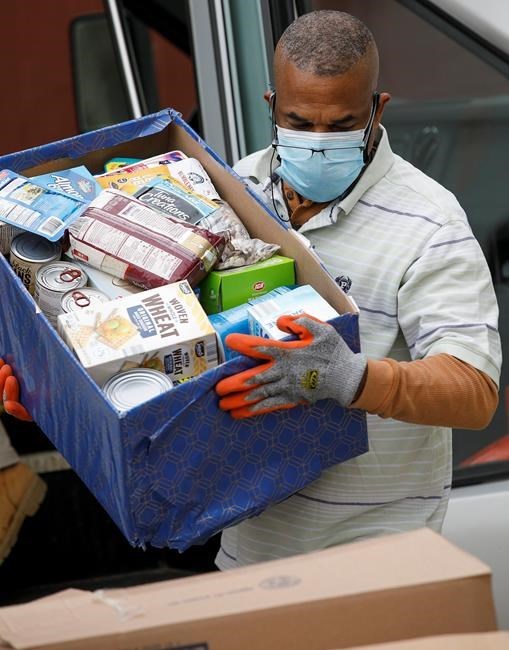
Maurice Davis, order selector, helps unload food donations from a Masonicare van at Connecticut Food Bank in Wallingford, Conn., Tuesday, Jan. 19, 2021. Masonicare delivered 5,488 pounds of food, plus a monetary donation of $1,364, to Connecticut Food Bank headquarters Tuesday that had been collected in a month-long drive. (Dave Zajac/Record-Journal via AP)
Republished February 17, 2021 - 6:16 AM
Original Publication Date February 17, 2021 - 5:36 AM
Fidelity Charitable, the nation’s largest grant maker, has reported a banner 2020, with donations surging 24% from 2019 to $9.1 billion — by far the largest total on record. Yet so deep were the hardships caused by the viral pandemic that even a record high in contributions fell well short of the need.
The charity reported Wednesday that donations to charities that address food insecurity rocketed up 1,200%, with Feeding America, Meals on Wheels and World Central Kitchen becoming among Fidelity Charitable’s Top 20 most popular charities for the first time. And contributions to the CDC Foundation, which advances the mission of the Centers for Disease Control and Prevention, jumped 9,582%.
Yet in contrast to food and medical research, some other sectors of philanthropy, especially those in arts and culture, have not fared so well. A survey of nonprofits by CCS Fundraising found that donations declined at roughly 44% of the charities and increased at 38.6% of them. Those figures are supported by a recent Wells Fargo/Gallup study that found that 20% of investors who were surveyed donated less in 2020 because of the pandemic; 18% gave more.
“We’re just really proud to be able to get this much money out to nonprofits during a time of crisis,” said Pamela Norley, president of Fidelity Charitable, which handles donor-advised funds and is independent of Fidelity Investments. “2020 was a terrible year for so many organizations, and our donors jumped into the opportunity to be able to give money away from their donor-advised funds.”
Even at the CDC Foundation, which benefited from a boom in donations last year, the additional funding didn’t come close to matching the outsize demand generated by the pandemic, said Judy Monroe, president and CEO of the CDC Foundation.
“We’ve been really pleased with what we’ve been able to do,” Monroe said. “But the short answer is we could have used a lot more.”
Monroe said the additional money that poured in starting last spring was used to pay for some initiatives from the Centers for Disease Control and Prevention before government funding arrived. The CDC Foundation helped state health departments buy COVID-19 testing equipment. It funded early research at the University of California San Francisco on the effects of COVID-19 on pregnant women and infants. And it supported the early development of the Sara Alert system, which enables contact tracing.
Even so, the CDC Foundation lacked enough funding to fully support some projects involved in monitoring the effectiveness of COVID-19 preventative measures in schools. Monroe said that numerous international programs that the foundation wanted to support had to be delayed.
Such difficult choices are common among nonprofits and will likely continue this year, said Robert Kissane, chairman of CCS Fundraising, a global fundraising consulting and management firm.
“We see a spike in giving — some really enormous gifts and then some grassroots help,” he said of donations during 2020. “But it never keeps up with demand.”
The economic downturn and the police killing of George Floyd fueled increases in donations to fight food insecurity and racial injustice, Kissane said. Yet much of the funding, he said, was directed toward well-known charities, while newer, less-established nonprofits suffered from a decline.
The philanthropy sector has lost about 960,000 jobs since the pandemic began, with the deepest cuts coming in the arts and education fields, according to a report that the John Hopkins Center for Civil Society Studies released Tuesday. It estimates that it will take until 2023 for the sector to regain its pre-pandemic levels of employment.
The most recent CCS Fundraising survey of more than 1,000 nonprofits helps explain the delay: About 43% of the nonprofits surveyed said they expect their fundraising to decline in 2021. Only about 27% expect an increase.
That is due, in part, to fewer people who are donating. Kissane noted that half of the $400 billion donated to charities each year now comes from only 1% of American households, whereas in the past, much of the money typically came from a sizable proportion of American families with household incomes of $100,000 or less.
“Philanthropy in America has evolved,” Kissane said. “That appears to be a direct correlation to the economic crisis and the recovery that was not seen among working class folks.”
People who have fared well in the stock market or, in some cases, from cryptocurrency trading seem poised to increase their donations. Norley of Fidelity Charitable said grant-making in the charity’s donor-advised funds — which accept cash, publicly traded securities, cryptocurrency and even limited partnership interests to establish tax-free accounts — is so far up 50% in this year.
“We’re trying to make sure people know this isn’t over,” she said. “It’s important for people to recognize that there’s still a huge demand for funding.”
___
The Associated Press receives support from the Lilly Endowment for coverage of philanthropy and nonprofits. The AP is solely responsible for all content.
News from © The Associated Press, 2021